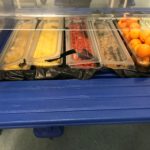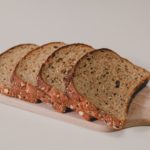Cooking with Your Kids
Since we are staying home many of our normal routines have been disrupted. This can throw us off and create a sense of uneasiness. Instead of focusing on all the things we can’t do, use this time to develop a new routine to fit these current circumstances. If you are a parent, cooking and feeding your kids healthy meals is likely be on the list of challenges you are facing during this time. Choose to develop a new routine around meals. Involve your kids in the meal planning and cooking process. Let them choose the vegetables they want for dinner, and come up with theme dinner nights to keep things fun. If anything, cooking with your kids will let you spend time together and give them something to do. Cooking is a valuable life skill that teaches children about nutrition and food safety, as well as building math, science, literacy and fine motor skills.
Encourage your kid’s interest and excitement in healthy foods by teaching them how to cook safely with this guide of age-appropriate kitchen activities.
3-5 year olds
Young children love to help out, but they need very close adult supervision since their motor skills are still developing. Teach these youngsters the importance of washing produce and using clean appliances and utensils.
Appropriate Tasks:
- Wash hands with warm, soapy water for at least 20 seconds. Make it a game by singing the “Happy Birthday” song together twice as you wash your hands.
- Wash fruits and vegetables in the sink with cool tap water.
- Wipe tabletops.
- Mix ingredients like easy-to-mix batters.
- Brush (or “paint”) cooking oil with a clean pastry brush on bread, asparagus or other foods.
- Cut cookies with fun shaped cookie cutters
- Squeezing lemons or limes
- Tearing up lettuce
- Kneading dough
6-7 year olds
Most 6-7 year olds have developed fine motor skills, so they can handle more detailed work, but they will still need food safety reminders.
Appropriate Tasks:
- Use a peeler to peel raw potatoes, ginger, mangoes and other washed fruits and vegetables.
- Break eggs into a bowl and remember to wash hands afterwards.
- Scoop out avocados after sliced in half by an adult.
- Deseed tomatoes and cooled, roasted peppers with a spoon.
- Snap green beans.
- Load the dishwasher.
- Shuck corn and rinse before cooking.
- Rinse and cut parsley or green onions with clean, blunt kitchen scissors.
8-9 year olds
There is a wide range of skills in this age group, so tailor your tasks to each child’s maturity level. Teach the importance of wiping down all surfaces and refrigerating perishables, such as eggs and milk, right away.
Appropriate Tasks:
- Open cans with a can opener.
- Put leftovers in shallow containers and refrigerate within two hours (one hour if it’s warmer than ninety degrees).
- Pound chicken on a cutting board. Note: Always use a separate cutting board for ready-to-eat and raw foods, and be sure to wash hands with warm, soapy water after handling raw meats and chicken.
- Beat eggs.
- Check the temperature of meat with a food thermometer – it’s like a science experiment!
- Juice a lemon or orange.
10-12 year olds
For the most part, kids ages 10 -12 can work independently in the kitchen, but they should still have adult supervision. Before letting these kids do grown-up tasks on their own, assess whether they can follow basic kitchen rules such as adjusting pan handles over counters to avoid bumping into them, unplugging electrical appliances, using knives and safely using the oven or microwave.
Appropriate Tasks (with adult supervision):
- Boil pasta.
- Microwave foods.
- Follow a recipe, including reading each step-in order and measuring ingredients accurately.
- Bake foods in the oven.
- Simmer ingredients on the stove.
- Slice or chop vegetables.
Cooking together can be a fun way to teach your child valuable skills, promote good nutrition and make long-lasting memories in the process.









